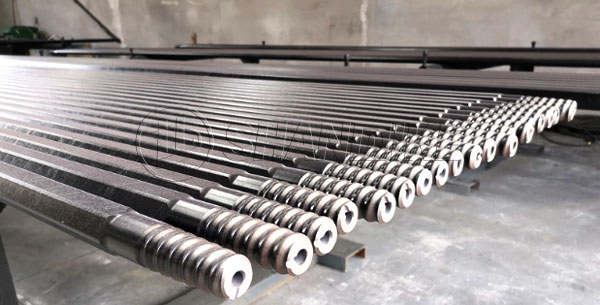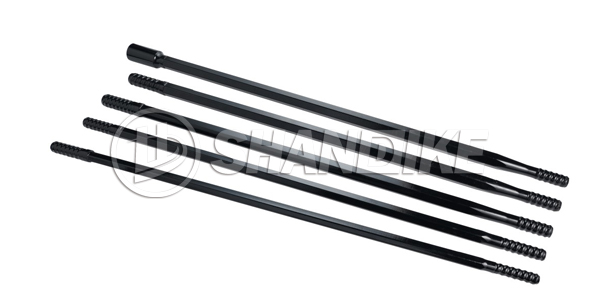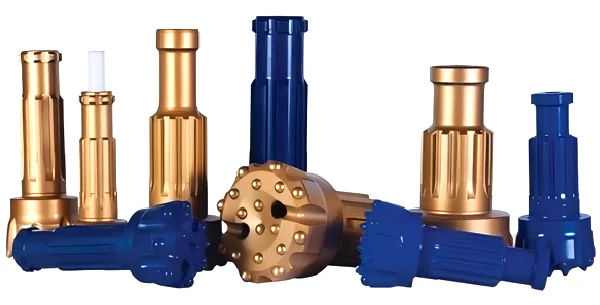Rods and Bits for Pneumatic Rock Drills: Essential Components for Drilling Performance
Pneumatic rock drills are fundamental tools in mining, quarrying, and construction for drilling blast holes. While the drill itself delivers the percussive force, optimal performance relies heavily on two critical consumables: the drill rod and the drill bit. Understanding their roles and interaction is key to efficient and productive drilling.
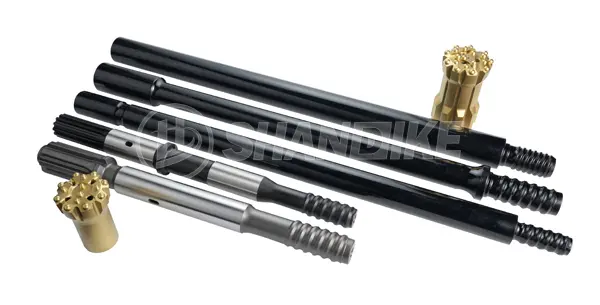
- Drill Rods: The Conduit for Energy Function: Rods transmit the drill’s percussive blows and rotational torque from the drill steel chuck to the bit at the rock face. They also provide the conduit for flushing air or water to remove drill cuttings.
Construction: Typically made from high-strength, heat-treated alloy steel to withstand immense impact and torsional stresses. Hollow centers allow for flushing media.
Types & Lengths:
Starter Rods (Collars): Shorter, robust rods directly connected to the drill chuck. They absorb the initial impact and stabilize the drill string.
Extension Rods: Added between the starter rod and bit to achieve greater hole depths. Lengths vary (commonly 0.8m, 1.2m, 1.8m, 3m / 3ft, 4ft, 6ft, 10ft).
Threading: Precision threads at both ends are crucial. They must:
Match: Thread type (e.g., R32, T38, T45, ST58) must be compatible between rods, bits, and the drill chuck.
Seal: Ensure efficient flushing pressure by preventing air/water leakage.
Be Robust: Resist wear, deformation, and cross-threading to prevent premature failure or rod jamming.
Key Rod Considerations: Strength, straightness, thread integrity, and compatibility are paramount. Worn or mismatched rods lead to energy loss, poor hole straightness, and increased downtime. - Drill Bits: The Cutting Interface Function: Bits directly fracture the rock. They receive impact energy and rotation from the rod, focusing it onto the rock surface to break it apart.
Construction: The body is forged steel. The cutting edge consists of hardened tungsten carbide inserts (buttons) due to their extreme hardness and wear resistance.
Common Bit Types:
Button Bits: Feature hemispherical or ballistic-shaped carbide buttons. Dominant type for most medium-hard to very hard rock formations. Offer good penetration rates, hole straightness, and button life. Available in convex (common) or concave face profiles.
Cross Bits: Feature a cruciform-shaped cutting edge, usually with carbide inserts at the points. Historically common but largely superseded by button bits in most applications. May still be used in specific soft rock or specialized situations.
Bit Shank: The rear section features threads compatible with the rod threads (e.g., R32, T38). A snug, precise fit is essential for efficient energy transfer.
Gauge Buttons: Buttons positioned around the bit’s circumference are critical for maintaining correct hole diameter and bit stability.
Key Bit Considerations: Button geometry/profile, carbide quality/grade, gauge protection, and precise shank threading determine drilling speed, bit life, and hole quality. Bit selection is heavily influenced by rock type and hardness. - The Critical Synergy
Rods and bits work inseparably:
- Energy Transfer: The rod must efficiently transmit impact and rotation to the bit without significant loss due to flexing, poor threads, or misalignment.
- Flushing: The aligned hollow passages allow flushing media to reach the bit face, clearing cuttings and cooling the bit. Blockages or leaks severely hinder performance.
- Compatibility: Mismatched threads prevent proper connection, leading to rapid thread wear, energy loss, and potential breakage.
- Wear Progression: Both rods and bits wear continuously. As buttons wear down, penetration rate decreases. Rod threads wear, reducing connection integrity and flushing efficiency. Using excessively worn components drastically reduces overall drilling efficiency and risks breakage.
- Selection and Performance Factors
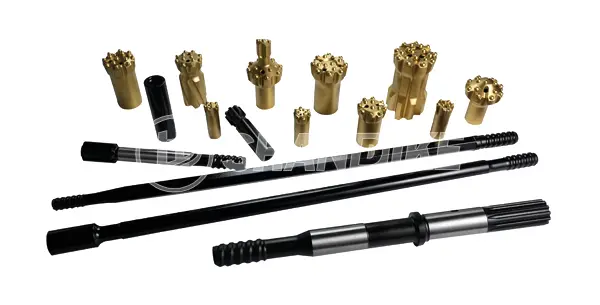
Choosing the right rod and bit combination depends on:
Rock Type & Hardness: Dictates bit type (button profile) and carbide grade.
Hole Diameter: Determines bit size and required rod diameter/shank size.
Hole Depth: Dictates the number and length of extension rods needed.
Drill Model & Power: Must match the shank/thread size (e.g., R32, T38) and be compatible with the drill’s power output.
Flushing Medium: Air or water? Impacts bit design (e.g., water ports).
Conclusion
Drill rods and bits are far more than simple accessories for pneumatic rock drills; they are precision-engineered, consumable components fundamental to the drilling process. Their quality, compatibility, and condition directly dictate drilling speed, efficiency, hole quality, and operational costs. Selecting the appropriate rod and bit combination for the specific rock conditions and drill, and maintaining them properly, is essential for achieving safe, productive, and cost-effective drilling operations. Focus on thread integrity, material quality, and timely replacement to maximize performance.
